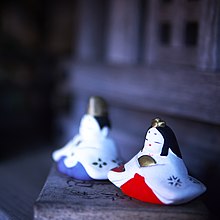
A katashiro (形代) is a kind of yorishiro where a kami is said to enter which has a human form. In Shinto rituals and folk customs, dolls are used as human substitutes to transfer sins and impurities during exorcisms. They are usually made of paper or thin boards. After the exorcism, they are thrown into the river or sea, or burned. During Hinamatsuri in March, people use these dolls as nademono (撫で物) to stroke the parts of their bodies that are not in good shape, and then cast them into the river or sea to pray for the growth of their children.
History

Katashiro is said to have existed since Ancient times, and has been found in Dogu from the Jōmon period, human-faced earthenware from the Yayoi period, and human haniwa from the Kofun period. Since they were to be flushed with water, plants and trees were used as materials. In Japan, from ancient times to the present, an event called "Oharai", which is described in Kojiki and Enki-Shiki, has been held at Shinto shrines all over Japan. In this event, people blow on the dolls distributed by the shrine and stroke the parts of the body that are not in good shape to remove impurities, and then throw them into the river or sea. This act of "letting go" is later associated with wish-fulfillment, and is sometimes linked to the Tanabata Festival held at the same time, when tanzaku (short strips of paper) are leaked. The burning of dolls, strips of paper, and bamboo is partly performed, but this is an event derived from Donton-yaki and Esoteric Buddhism, and is thought to have been mixed in with Shinbutsu-shūgō.
Remnants
Today's "Nagashi-bina [ja]" and "Tanabata-bina" are said to be remnants of Katashiro.
See also
References
- "Encyclopedia of Shinto詳細". 國學院大學デジタルミュージアム (in Japanese). Retrieved 2023-03-11.
- 第2版, 日本大百科全書(ニッポニカ),精選版 日本国語大辞典,ブリタニカ国際大百科事典 小項目事典,デジタル大辞泉,百科事典マイペディア,世界大百科事典. "形代とは". コトバンク (in Japanese). Archived from the original on 2022-02-26. Retrieved 2022-02-26.
{{cite web}}: CS1 maint: multiple names: authors list (link) CS1 maint: numeric names: authors list (link) - ^ "こんな話知ってる?雛人形豆知識". Archived from the original on 2020-10-30. Retrieved 2020-10-27.
- Davies, Jake. "Nagashibina Doll Museum". JapanVisitor Japan Travel Guide. Archived from the original on 18 June 2018. Retrieved 1 March 2018.
External links
- こんな話知ってる?雛人形豆知識 - こうげつ人形
| Shinto shrines | |||||||||||||||||||||||||||||
|---|---|---|---|---|---|---|---|---|---|---|---|---|---|---|---|---|---|---|---|---|---|---|---|---|---|---|---|---|---|
| |||||||||||||||||||||||||||||
| |||||||||||||||||||||||||||||